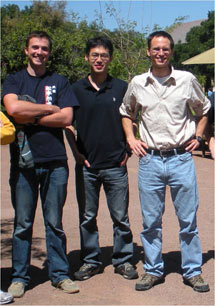
Handy Links
SLAC News Center
SLAC Today
- Subscribe
- Archives: Feb 2006-May 20, 2011
- Archives: May 23, 2011 and later
- Submit Feedback or Story Ideas
- About SLAC Today
SLAC News
Lab News
- Interactions
- Lightsources.org
- ILC NewsLine
- Int'l Science Grid This Week
- Fermilab Today
- Berkeley Lab News
- @brookhaven TODAY
- DOE Pulse
- CERN Courier
- DESY inForm
- US / LHC
SLAC Links
- Emergency
- Safety
- Policy Repository
- Site Entry Form

- Site Maps
- M & O Review
- Computing Status & Calendar
- SLAC Colloquium
- SLACspeak
- SLACspace
- SLAC Logo
- Café Menu
- Flea Market
- Web E-mail
- Marguerite Shuttle
- Discount Commuter Passes
-
Award Reporting Form
- SPIRES
- SciDoc
- Activity Groups
- Library
Stanford
Around the Bay
New Common Link Found for High-temperature Superconductors
A research group led by Ian Fisher of the Stanford Institute for Materials and Energy Science, a joint SLAC-Stanford institute, has found an odd property in a particular material belonging to a family of high-temperature superconducting compounds called iron pnictides: under certain conditions, electrons flow through the material much more easily in one direction than the other.
The research is covered in a paper appearing online today in the journal Science. The paper discusses not only this imbalance in conductivity, called an "in-plane anisotropy," but also the fact that the group's research required some innovative experimental techniques, including the development of a completely new tool for "detwinning" miniscule crystals.
"In its own right, the question of what's causing this phenomenon of electronic anisotropy is intriguing, and is something that we really want to understand," Fisher said.
But it's what the paper doesn't say that that has him truly excited.
A similar anisotropy, or imbalance, also appears in the cuprates, the only other known family of high-temperature superconductors. Resistance to the flow of electrons in both these families of compounds drops to zero at higher temperatures compared to conventional superconductors and researchers—along with everyone who pays a power bill—would like to know why. Today's result gives researchers a new way to explore that question.
The cuprates have been around since 1986, and, although considerable progress has been made, the origin of their high-temperature superconductivity remains poorly understood. In contrast, superconductivity in the iron-based materials was discovered only two years ago, and as the research done by Fisher's group shows, at least where the electronic anisotropy is concerned, the iron pnictide family of compounds has already been more forthcoming.
As Fisher explained, the material's transition from a state in which it does not display electronic anisotropy to the state in which it does involves a phase transition—a change in the state of the material. In this case, the material undergoes what scientists term a "nematic" phase transition, in which the crystal's structure distorts from a square to a rectangular shape. Though the cuprates share a similar anisotropy, they don't exhibit the same clear phase transition, making this aspect of their behavior much harder to both study and interpret compared to the iron-based material in this study.
Don't think getting the iron pnictides to fess up was easy, though. When cooled so that the material passes through its phase transition, the crystals tended to form "twins"—regions of the material for which the rectangles pointed in different directions. As a result, no single route existed for the electrons to take along their preferred direction.
For the solution, group members Jiun-Haw Chu and James Analytis devised an instrument that basically applied pressure to the crystals to "detwin" them—that is, to ensure that all of the rectangles were oriented in the same direction.
"It was quite tricky to do this," Fisher said. Working with collaborators at the Advanced Photon Source at Argonne National Laboratory and Stanford's E. L. Ginzton Laboratory, the team was able to show that the device worked, and that the crystals were indeed detwinned.
That accomplished, they retested the crystals and found that electrons were about twice as inclined to travel along one axis of the crystal sheet as the other.
So now, in addition to an already-identified similarity in magnetic properties, another commonality between the two families of high temperature superconductors has been identified. Next question: does either of these properties enable high temperature superconductivity? And if so, how?
"That's what makes this result so exciting—it gives another perspective on an old problem, and that's when you begin to make progress," Fisher said. "People have been banging their heads on cuprates for 20 years. But maybe the pnictides and the cuprates aren't so very different. Maybe if you can solve one problem you can solve them both."
The real goal, Fisher emphasized, is to uncover a general solution that could apply to other materials or even higher temperature regimes.
"It's not just trying to understand the behavior of a particular material," he said, "but trying to look forward." Forward to superconductors that work at even higher temperatures? Fisher grinned. "Or, dare I say it—room temperature superconductors?"
"If we can understand what makes both the cuprates and the iron pnictides tick, we might be able to develop the tools to help us systematically hunt for the next generation of even higher temperature superconductors. That would be something to get really excited about."
—Lori Ann White
SLAC Today, August 13, 2010
